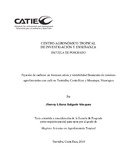| dc.contributor.advisor | Casanoves, Fernando | es_ES |
| dc.contributor.author | Salgado, Jehnny | |
| dc.contributor.other | CATIE - Centro Agronómico Tropical de Investigación y Enseñanza | |
| dc.coverage.spatial | Turrialba, Costa Rica | |
| dc.date.accessioned | 2021-05-04T20:20:57Z | |
| dc.date.available | 2021-05-04T20:20:57Z | |
| dc.date.issued | 2010 | |
| dc.identifier.uri | https://repositorio.catie.ac.cr/handle/11554/10779 | |
| dc.description | Tesis (Mag. Sc.) - CATIE, Turrialba (Costa Rica), 2010 | es_ES |
| dc.description.abstract | En este estudio pretendió evaluar la fijación de carbono y la rentabilidad financiera de los sistemas agroforestales con café tratados bajo manejos convencionales y orgánicos. El trabajo se realizó en dos ensayos establecidos en el año 2000 por el Centro Agronómico Tropical de Investigación y Enseñanza (CATIE) junto con la Unión Nicaragüense de Cafetaleros (UNICAFE), la Universidad Nacional Agraria (UNA), el Instituto Nicaragüense de Tecnología agropecuaria (INTA), la Universidad de Costa Rica (UCR) y el Instituto del Café en Costa Rica (ICAFE).Para evaluar la fijación de carbono de los sistemas, se realizó un muestreo destructivo de árboles en asocio con los que se cuantificó la biomasa aérea. Con estos valores se construyeron modelos de biomasa para cada especie establecida (Inga laurina, Samanea saman, Tabebuia rosea, Simarouba glauca, Chloroleucon eurycyclum (Abarema idiopoda), Terminalia amazonia) con los que se estimó la biomasa total aérea de cada sistema. En este ensayo, los sistemas convencionales mostraron valores negativos de rentabilidad. Es importante considerar que para el análisis de este ensayo, se consideraron ocho años de manejo de la plantación. | es_ES |
| dc.description.abstract | This study evaluates the carbon fixation and profitability of coffee agroforestry plantations under two management practices: conventional and organic. The study sites were located in Turrialba, Costa Rica, and Masatepe, Nicaragua. The institutions that participated were: Tropical Agricultural Research and Higher Education Center (CATIE). The University of Costa Rica (UCR) and the Costa Rican Institute for the Coffee (ICAFE).To evaluate the carbon fixation, a destructive sampling method was used, taking down trees and measuring above-ground biomass. With these values species-specific XII biomass models were developed for the following: Inga laurina, Samanea saman, Tabebuia Rosea, Simarouba glauca, Chloroleucon eurycyclum (Abarema idiopoda), Terminalia amazonia once the total aerial biomass of each system was determined, all systems were compared considering shade species and input applications.All conventional systems showed negative values of profitability. In order to asses these all 8 years of plantation management were used. | |
| dc.format.extent | 126 páginas | |
| dc.language.iso | es | es_ES |
| dc.publisher | Centro Agronómico Tropical de Investigación y Enseñanza (CATIE) | es_ES |
| dc.relation.ispartof | Magister Scientiae en Agroforestería Tropical | |
| dc.rights | info:eu-repo/semantics/openAccess | es_ES |
| dc.rights | CC-BY-4.0 | |
| dc.subject | MERCADO | |
| dc.subject | PRODUCCION | |
| dc.subject | INVERSIONESCOFFEA ARABICA | |
| dc.subject | ALBIZIA SAMAN | |
| dc.subject | AGROFORESTERIA | |
| dc.subject | BIOMASA | |
| dc.subject | PLANTAS DE SOMBRA | |
| dc.subject | RENTABILIDAD | |
| dc.subject | NICARAGUA | |
| dc.subject | AGROFORESTRY | |
| dc.subject | BIOMASS | |
| dc.subject | SHADE PLANTS | |
| dc.subject | PROFITABILITY | |
| dc.subject.other | Sede Central | |
| dc.title | Fijación de carbono en biomasa aérea y rentabilidad financiera de sistemas agroforestales con café en Turrialba, Costa Rica y Masatepe, Nicaragua | es_ES |
| dc.title.alternative | Carbon sequestration and financial profitability of coffee agroforestry in Turrialba, Costa Rica and Masatepe, Nicaragua. | es_ES |
| dc.type | Tesis | es_ES |
| dc.status | info:eu-repo/semantics/openAccess | |
| dc.creator.id | https://orcid.org/0000-0003-3191-2259 | |


